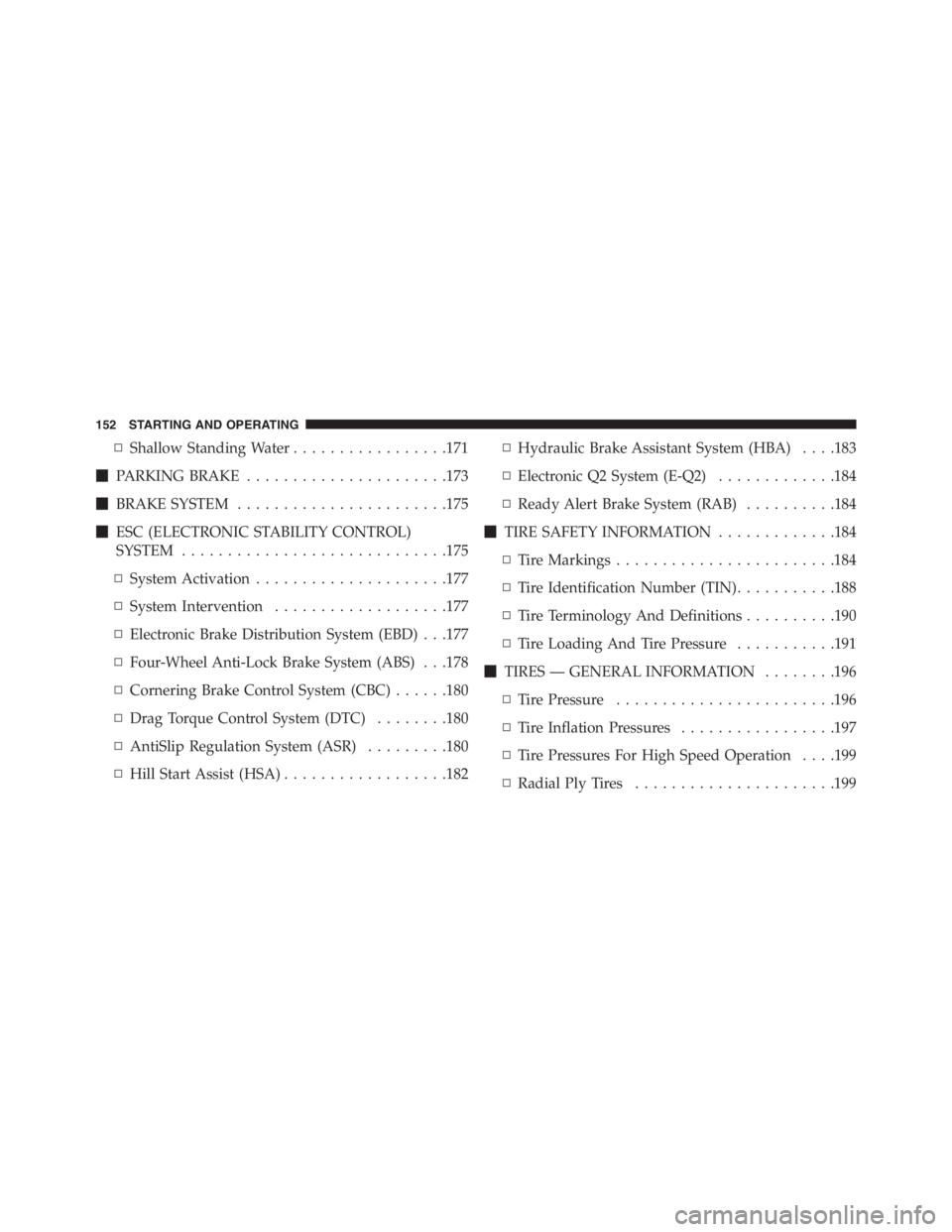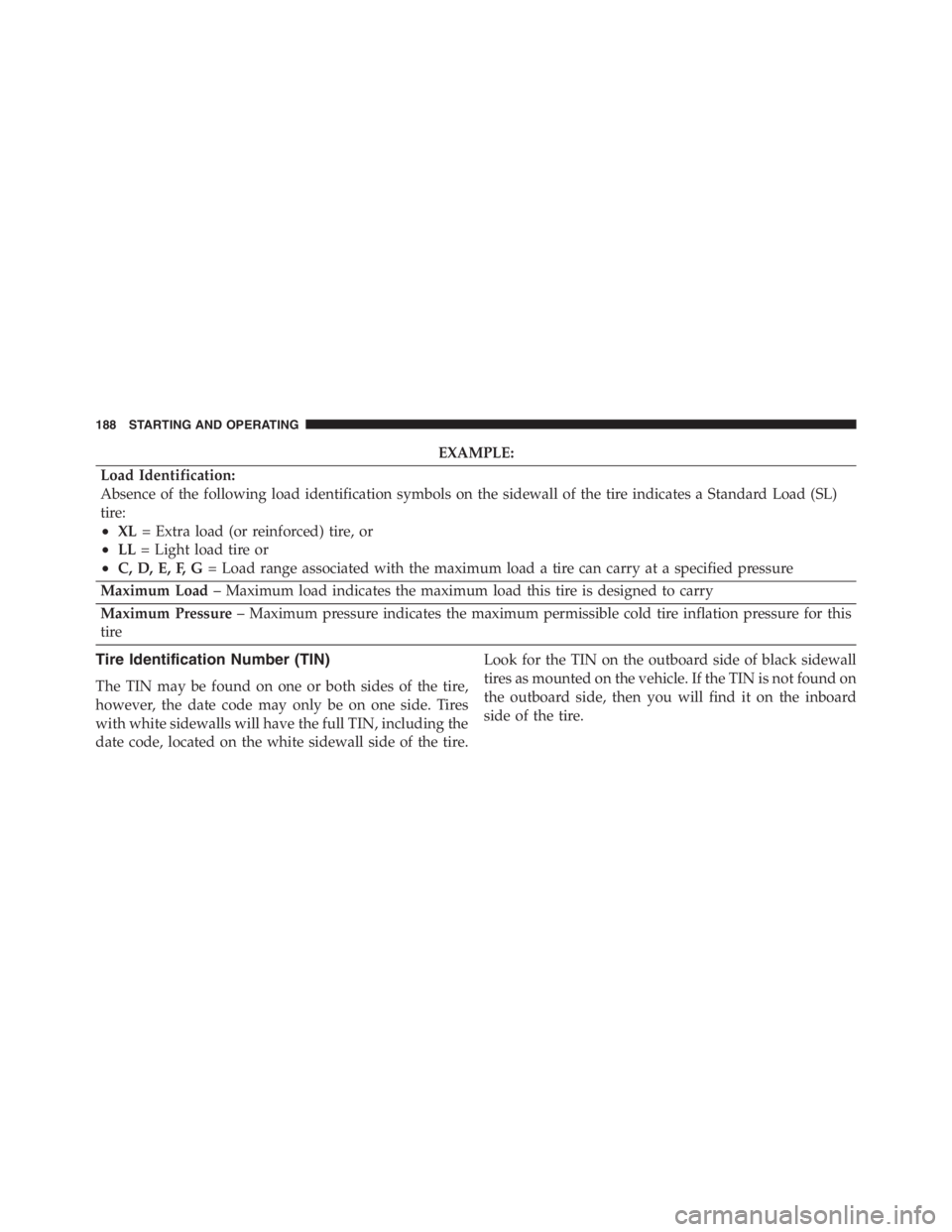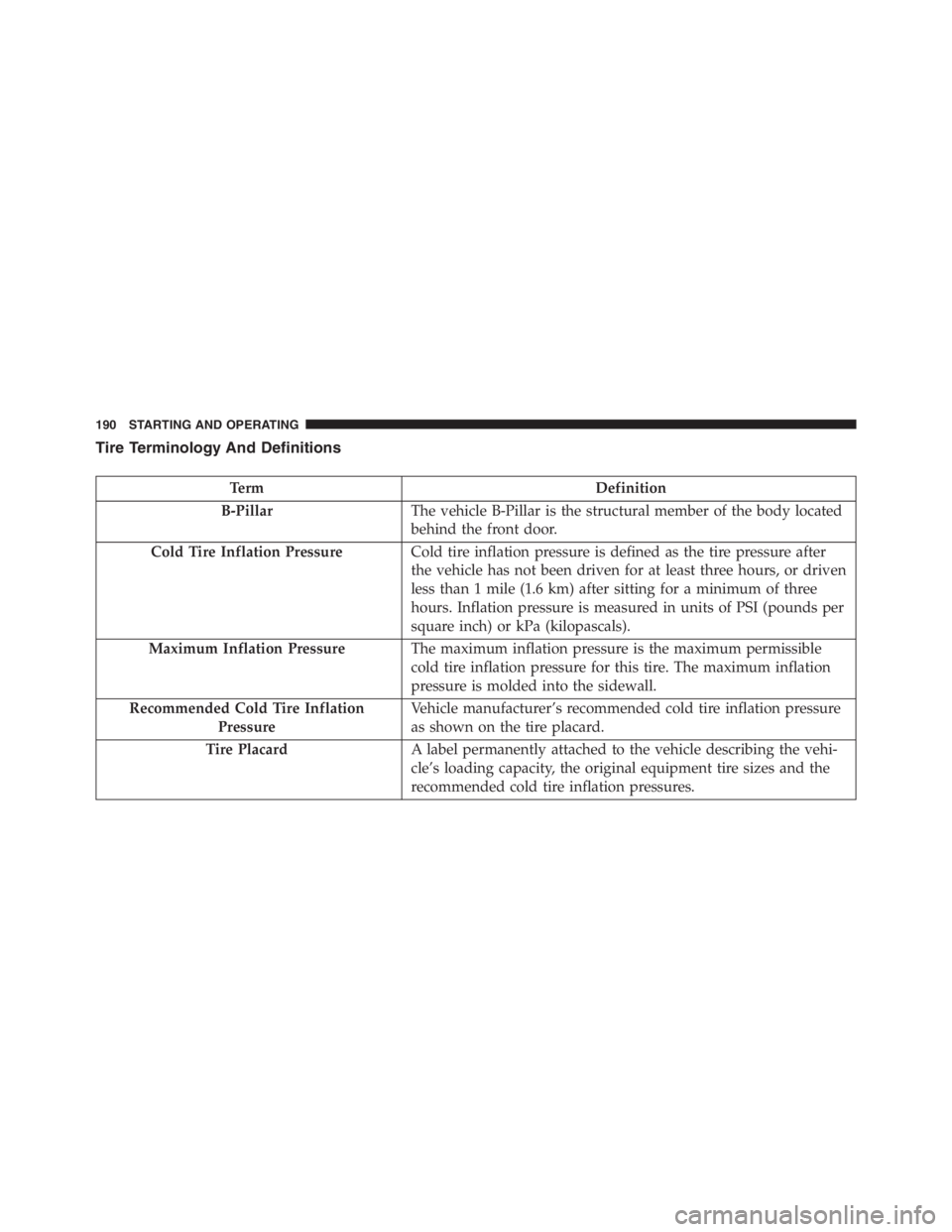Page 114 of 348

INSTRUMENT CLUSTER DESCRIPTIONS
1. Tire Pressure Monitoring Telltale Light — If Equipped
Each tire, including the spare (if provided),
should be checked monthly when cold and
inflated to the inflation pressure recommended
by the vehicle manufacturer on the vehicle
placard or tire inflation pressure label. (If your vehicle
has tires of a different size than the size indicated on the
vehicle placard or tire inflation pressure label, you should
determine the proper tire inflation pressure for those
tires.)
As an added safety feature, your vehicle has been
equipped with a Tire Pressure Monitoring System
(TPMS) that illuminates a low tire pressure telltale when
one or more of your tires is significantly under-inflated.
Accordingly, when the low tire pressure telltale illumi-
nates, you should stop and check your tires as soon as
possible, and inflate them to the proper pressure. Drivingon a significantly under-inflated tire causes the tire to
overheat and can lead to tire failure. Under-inflation also
reduces fuel efficiency and tire tread life, and may affect
the vehicle’s handling and stopping ability.
Please note that the TPMS is not a substitute for proper
tire maintenance, and it is the driver ’s responsibility to
maintain correct tire pressure, even if under-inflation has
not reached the level to trigger illumination of the TPMS
low tire pressure telltale.
Your vehicle has also been equipped with a TPMS
malfunction indicator to indicate when the system is not
operating properly. The TPMS malfunction indicator is
combined with the low tire pressure telltale. When the
system detects a malfunction, the telltale will flash for
approximately one minute and then remain continuously
illuminated. This sequence will continue upon subse-
quent vehicle start-ups as long as the malfunction exists.
When the malfunction indicator is illuminated, the sys-
tem may not be able to detect or signal low tire pressure
112 UNDERSTANDING YOUR INSTRUMENT PANEL
Page 154 of 348

▫Shallow Standing Water.................171
�PARKING BRAKE......................173
�BRAKE SYSTEM.......................175
�ESC (ELECTRONIC STABILITY CONTROL)
SYSTEM.............................175
▫System Activation.....................177
▫System Intervention...................177
▫Electronic Brake Distribution System (EBD) . . .177
▫Four-Wheel Anti-Lock Brake System (ABS) . . .178
▫Cornering Brake Control System (CBC)......180
▫Drag Torque Control System (DTC)........180
▫AntiSlip Regulation System (ASR).........180
▫Hill Start Assist (HSA)..................182▫Hydraulic Brake Assistant System (HBA). . . .183
▫Electronic Q2 System (E-Q2).............184
▫Ready Alert Brake System (RAB)..........184
�TIRE SAFETY INFORMATION.............184
▫Tire Markings........................184
▫Tire Identification Number (TIN)...........188
▫Tire Terminology And Definitions..........190
▫Tire Loading And Tire Pressure...........191
�TIRES — GENERAL INFORMATION........196
▫Tire Pressure........................196
▫Tire Inflation Pressures.................197
▫Tire Pressures For High Speed Operation. . . .199
▫Radial Ply Tires......................199
152 STARTING AND OPERATING
Page 155 of 348

▫Tire Types...........................200
▫Run Flat Tires — If Equipped.............202
▫Spare Tires — If Equipped...............202
▫Tire Spinning........................205
▫Tread Wear Indicators..................205
▫Life Of Tire.........................206
▫Replacement Tires.....................206
�TIRE CHAINS (TRACTION DEVICES).......208
�TIRE ROTATION RECOMMENDATIONS.....209
�TIRE PRESSURE MONITORING SYSTEM
(TPMS)..............................210
▫Base System.........................212
▫General Information...................215�FUEL REQUIREMENTS — 1.750 Turbo.......215
▫Reformulated Gasoline.................216
▫Gasoline/Oxygenate Blends..............216
▫MMT In Gasoline.....................216
▫Materials Added To Fuel................217
▫Fuel System Cautions...................217
▫Carbon Monoxide Warnings.............218
�ADDING FUEL/SMART FUEL.............219
�TRAILER TOWING.....................222
�RECREATIONAL TOWING (BEHIND
MOTORHOME, ETC.)...................222
▫Towing This Vehicle Behind Another Vehicle . .222
5
STARTING AND OPERATING 153
Page 172 of 348

Traction
When driving on wet or slushy roads, it is possible for a
wedge of water to build up between the tire and road
surface. This is known as hydroplaning and may cause
partial or complete loss of vehicle control and stopping
ability. To reduce this possibility, the following precau-
tions should be observed:
•Slow down during rainstorms or when the roads are
slushy.
•Slow down if the road has standing water or puddles.
•Replace tires when tread wear indicators first become
visible.
•Keep tires properly inflated.
•Maintain sufficient distance between your vehicle and
the vehicle in front of you to avoid a collision in a
sudden stop.Your vehicle may be equipped with a Limited Slip
Differential (LSD) that reduces, but does not eliminate,
the amount of wheel slip across a given axle for im-
proved handling.
DRIVING THROUGH WATER
Driving through water more than a few inches/
centimeters deep will require extra caution to ensure
safety and prevent damage to your vehicle.
170 STARTING AND OPERATING
Page 178 of 348

WARNING!
•Electronic Stability Control (ESC) cannot prevent
the natural laws of physics from acting on the
vehicle, nor can it increase the traction afforded by
prevailing road conditions. ESC cannot prevent all
collisions, including those resulting from excessive
speed in turns, driving on very slippery surfaces, or
hydroplaning. ESC also cannot prevent collisions
resulting from loss of vehicle control due to inap-
propriate driver input for the conditions. Only a
safe, attentive, and skillful driver can prevent col-
lisions.The capabilities of an ESC equipped ve-
hicle must never be exploited in a reckless or
dangerous manner which could jeopardize the us-
er ’s safety or the safety of others.
(Continued)
WARNING!(Continued)
•Vehicle modifications, or failure to properly main-
tain your vehicle, may change the handling charac-
teristics of your vehicle, and may negatively affect
the performance of the ESC system. Changes to the
steering system, suspension, braking system, tire
type and size or wheel size may adversely affect ESC
performance. Improperly inflated and unevenly
worn tires may also degrade ESC performance. Any
vehicle modification or poor vehicle maintenance
that reduces the effectiveness of the ESC system can
increase the risk of loss of vehicle control, vehicle
rollover, personal injury and death.
The ESC system uses sensors installed on the car to
determine the trajectory that the driver intends to follow
and compares it with the car ’s effective trajectory. When
176 STARTING AND OPERATING
Page 183 of 348

WARNING!(Continued)
•Vehicle modifications, or failure to properly main-
tain your vehicle, may change the handling charac-
teristics of your vehicle, and may negatively affect
the performance of the ESC system. Changes to the
steering system, suspension, braking system, tire
type and size or wheel size may adversely affect
ESC performance. Improperly inflated and un-
evenly worn tires may also degrade ESC perfor-
mance. Any vehicle modification or poor vehicle
maintenance that reduces the effectiveness of the
ESC system can increase the risk of loss of vehicle
control, vehicle rollover, personal injury and death.
This is an integral part of the ESC system and automati-
cally operates in the event of one or both drive wheels
slipping, loss of grip on wet roads (hydroplaning) and
acceleration on slippery, snowy or icy roads, etc.Depending on the slipping conditions, two different
control systems are activated:
•If the slipping involves both drive wheels, the ASR
system intervenes, reducing the power transmitted by
the engine.
•If the slipping only involves one of the drive wheels, it
also intervenes automatically, braking the wheel that is
slipping.
System Intervention
This is indicated by the flashing of the warning light on
the instrument panel, to inform the driver that the car is
in critical stability and grip conditions.
5
STARTING AND OPERATING 181
Page 190 of 348

EXAMPLE:
Load Identification:
Absence of the following load identification symbols on the sidewall of the tire indicates a Standard Load (SL)
tire:
•XL= Extra load (or reinforced) tire, or
•LL= Light load tire or
•C, D, E, F, G= Load range associated with the maximum load a tire can carry at a specified pressure
Maximum Load– Maximum load indicates the maximum load this tire is designed to carry
Maximum Pressure– Maximum pressure indicates the maximum permissible cold tire inflation pressure for this
tire
Tire Identification Number (TIN)
The TIN may be found on one or both sides of the tire,
however, the date code may only be on one side. Tires
with white sidewalls will have the full TIN, including the
date code, located on the white sidewall side of the tire.Look for the TIN on the outboard side of black sidewall
tires as mounted on the vehicle. If the TIN is not found on
the outboard side, then you will find it on the inboard
side of the tire.
188 STARTING AND OPERATING
Page 192 of 348

Tire Terminology And Definitions
Term Definition
B-PillarThe vehicle B-Pillar is the structural member of the body located
behind the front door.
Cold Tire Inflation PressureCold tire inflation pressure is defined as the tire pressure after
the vehicle has not been driven for at least three hours, or driven
less than 1 mile (1.6 km) after sitting for a minimum of three
hours. Inflation pressure is measured in units of PSI (pounds per
square inch) or kPa (kilopascals).
Maximum Inflation PressureThe maximum inflation pressure is the maximum permissible
cold tire inflation pressure for this tire. The maximum inflation
pressure is molded into the sidewall.
Recommended Cold Tire Inflation
PressureVehicle manufacturer’s recommended cold tire inflation pressure
as shown on the tire placard.
Tire PlacardA label permanently attached to the vehicle describing the vehi-
cle’s loading capacity, the original equipment tire sizes and the
recommended cold tire inflation pressures.
190 STARTING AND OPERATING